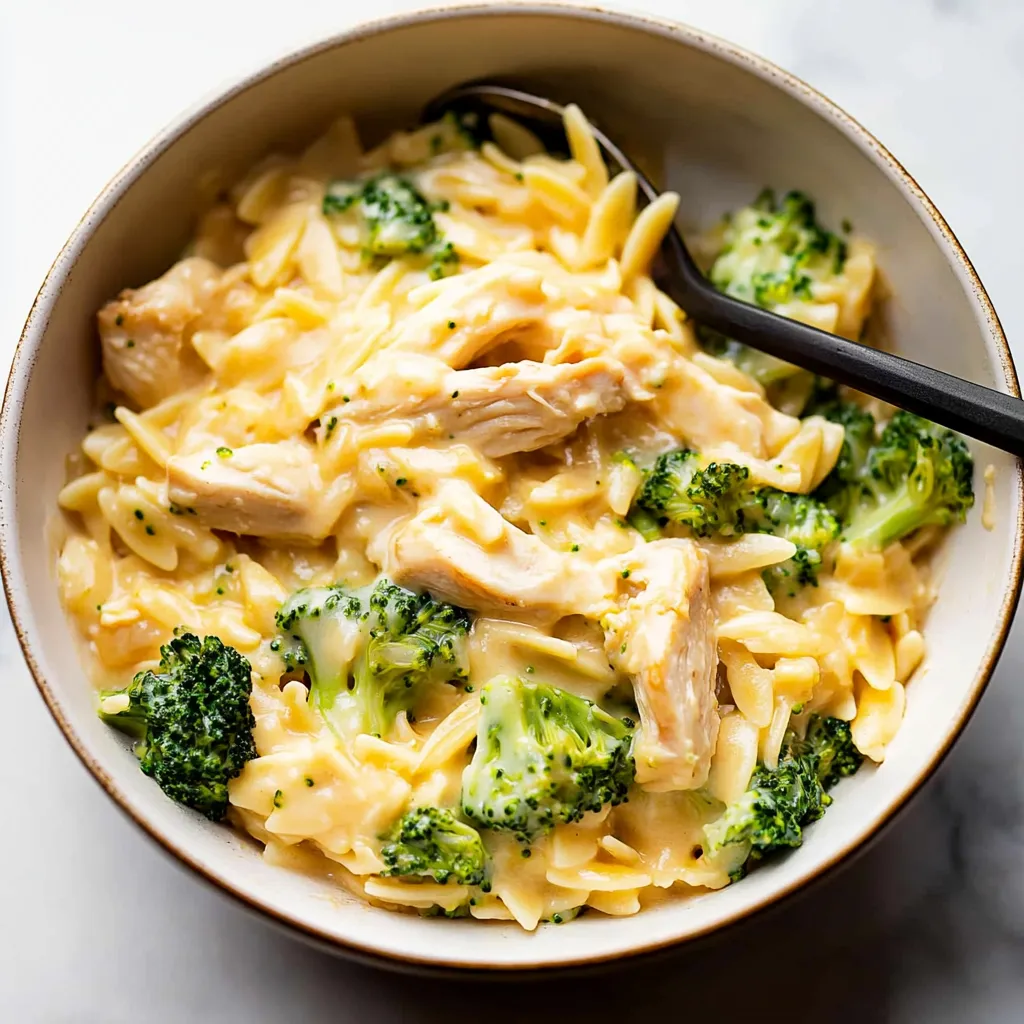 Pin it
Pin it
Perfect weeknight comfort awaits in this one-pot wonder that combines tender orzo pasta, rotisserie chicken, fresh broccoli, and melty cheddar cheese. This satisfying meal comes together in just thirty minutes while creating minimal dishes to wash afterward. The creamy, cheesy sauce brings everything together beautifully, making this dish a guaranteed family pleaser that delivers both nutrition and indulgence in every bite.
I created this recipe during an especially hectic week when my schedule left little time for elaborate cooking. My daughter typically picks around broccoli on her plate, but the first time I served this orzo, she actually asked for seconds without removing a single piece of green. My husband initially questioned the use of orzo instead of rice, but after his first bite declared it might be even better than our usual chicken and rice casserole. Now it appears regularly in our meal rotation, especially on nights when sports practices and homework leave little time for dinner preparation.
Key Ingredients
Flavor Foundation
- Olive Oil & Butter: This combination provides the perfect fat blend for sautéing—butter contributes rich flavor while olive oil prevents burning with its higher smoke point.
- Sweet Onion: Adds aromatic sweetness without sharp heat, creating depth in the dish while practically melting into the sauce during cooking.
- Fresh Garlic: Provides essential aromatic foundation that elevates all the other flavors while adding complexity that dried versions simply cannot match.
Veggie Goodness
- Broccoli Florets: These little green trees not only provide nutrition but absorb the flavors of the cheese and seasonings beautifully. Cutting them to a consistent size ensures even cooking throughout the dish.
- Italian Seasoning: This convenient herb blend typically includes basil, oregano, rosemary, thyme, and marjoram, adding depth without requiring multiple spice jars.
- Salt & Pepper: These fundamental seasonings enhance all other flavors when properly balanced and should be added generously to bring the dish to life.
Creamy Elements
- Orzo Pasta: This rice-shaped pasta cooks quickly while absorbing flavors more effectively than larger pasta shapes. Its small size distributes perfectly throughout the dish for consistent texture in every bite.
- Chicken Broth: Forms the savory liquid base that the orzo cooks in, infusing each grain with flavor rather than just boiling in plain water.
- Heavy Cream: Creates luxurious richness and silky texture in the sauce, transforming simple ingredients into something that tastes truly indulgent.
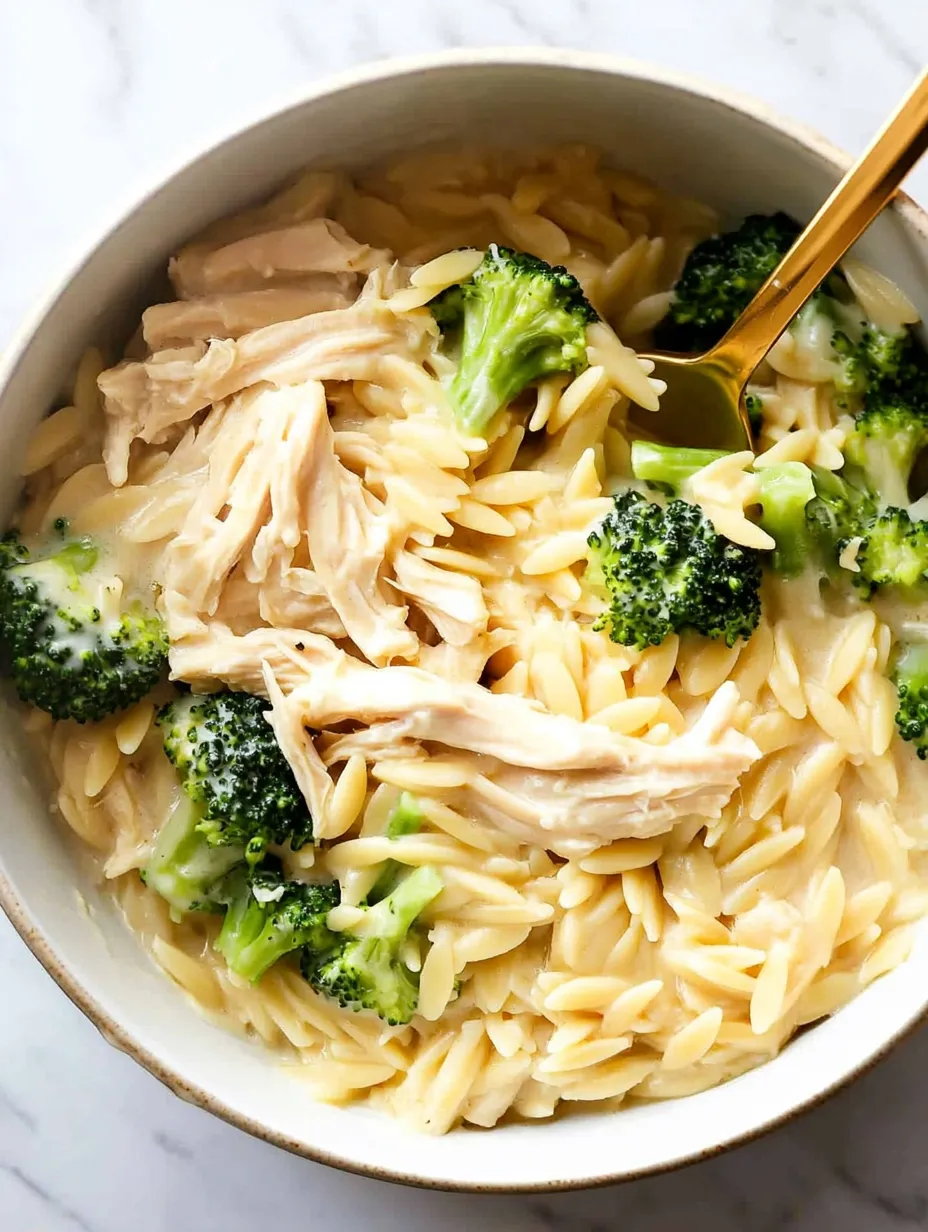 Pin it
Pin it
Protein & Cheese
- Rotisserie Chicken: This convenient time-saver provides perfectly cooked, flavorful protein without any additional preparation. The slight roasted flavor adds depth to the entire dish.
- Sharp Cheddar: Delivers bold, tangy flavor that stands up to the other ingredients. Freshly grated melts more smoothly than pre-shredded varieties, creating a silkier sauce texture.
- Worcestershire Sauce: This secret ingredient adds umami depth that's hard to identify but would be missed if omitted. Just a few dashes elevate the entire flavor profile.
Simple Preparation
Aromatic Beginning
Start by melting butter with olive oil in a large, deep skillet or Dutch oven over medium heat until the butter stops foaming. Add diced sweet onion and cook for about five minutes until it becomes translucent and begins to develop light golden edges, which adds significant flavor to the finished dish.
Vegetable Addition
Add your broccoli florets to the softened onions, stirring to coat them with the butter-oil mixture. Cook for another two to three minutes while stirring occasionally, allowing the broccoli to brighten in color while still maintaining some crispness, as it will continue cooking later in the process.
Pasta Preparation
Stir minced garlic, Italian seasoning, and dry orzo into the vegetable mixture, allowing these ingredients to toast slightly for about one minute. This brief cooking period wakes up the dried herbs and creates nutty notes in the pasta while preventing the garlic from burning or becoming bitter.
Liquid Integration
Pour chicken broth, heavy cream, and a few dashes of Worcestershire sauce into your skillet, stirring to combine while scraping any flavorful bits from the bottom of the pan. These browned bits contain concentrated flavor that will enrich your sauce as they dissolve into the liquid.
Gentle Simmering
Bring the mixture to a gentle boil before reducing the heat to maintain a steady simmer. Cover partially with a lid and cook for about 8-10 minutes, stirring occasionally to prevent sticking. During this time, the orzo will absorb the flavorful liquid while cooking to al dente perfection.
Consistency Check
Check that most liquid has been absorbed and the orzo is tender but still has slight resistance when bitten. If the mixture seems too dry before the pasta is fully cooked, add additional broth a quarter cup at a time. Conversely, if excess liquid remains, continue simmering uncovered until it reduces to your desired consistency.
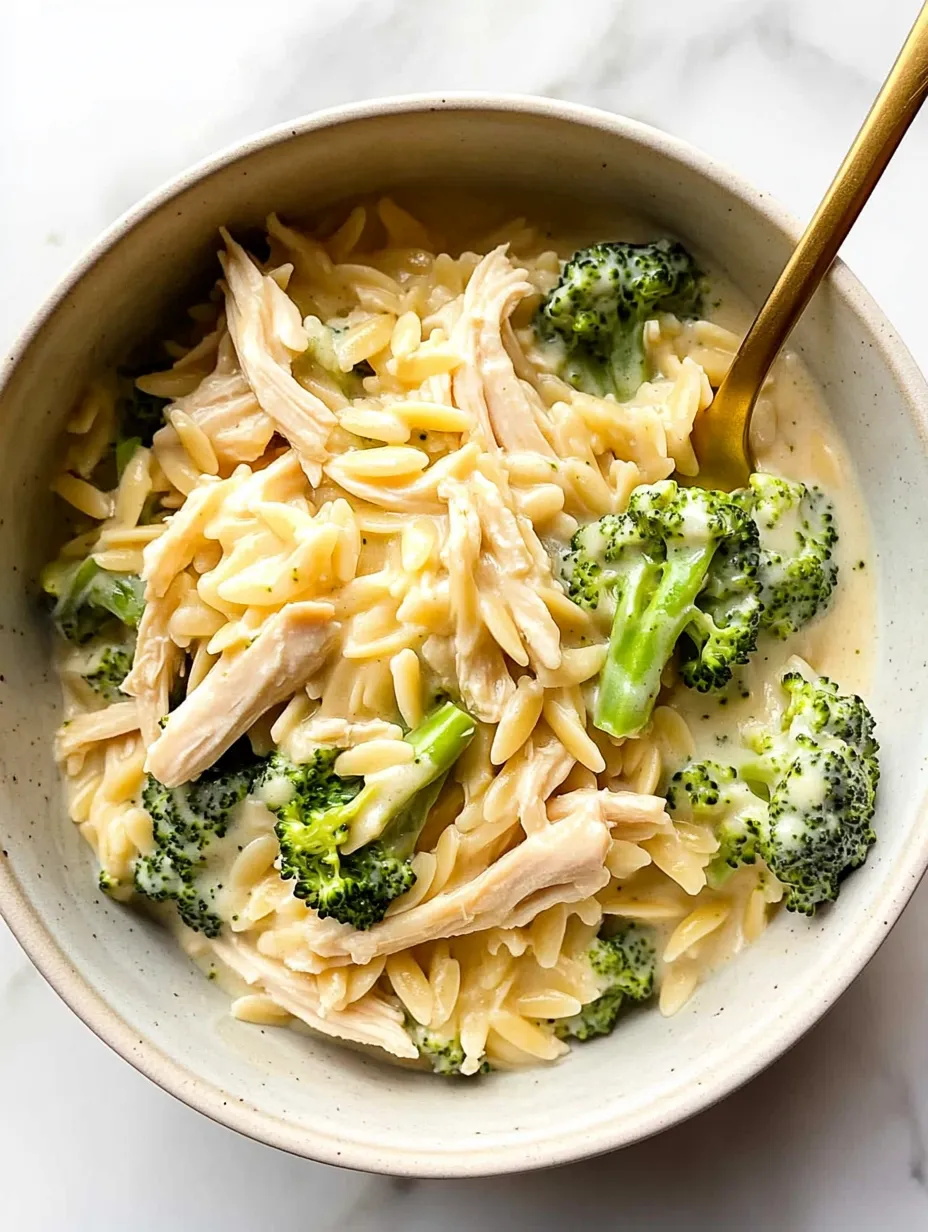 Pin it
Pin it
Protein Incorporation
Stir in the shredded rotisserie chicken, allowing it to warm through in the hot mixture for about two minutes. The chicken will absorb some of the sauce while contributing its own flavors back to the dish, creating a harmonious melding of elements.
Cheese Finishing
Remove the skillet from heat and immediately add the freshly grated sharp cheddar cheese. Stir continuously until the cheese melts completely, creating a smooth, creamy sauce that coats every piece of pasta, chicken, and broccoli. The residual heat melts the cheese gently without risking separation.
Final Seasoning
Taste the finished dish and season generously with salt and freshly ground black pepper. This final seasoning adjustment is crucial as the pasta and broccoli will have absorbed much of the initial salt from the broth, often necessitating additional seasoning to bring all flavors into proper balance.
The first time I made this dish, I hesitated when adding salt at the end, thinking the chicken broth and cheese would provide enough seasoning. My family politely ate their portions but didn't seem particularly enthusiastic. The next morning, I tasted the leftovers and realized the flavors seemed flat. I warmed a portion with an additional pinch of salt, and suddenly everything changed—all the flavors brightened and came together perfectly. Now I'm much more confident with that final seasoning step, recognizing that proper salt levels don't make food taste salty; they make food taste more like itself.
Serving Ideas
Transform this already complete meal into an even more satisfying spread by adding freshly baked garlic bread alongside. The crisp, buttery exterior and soft interior provide textural contrast to the creamy orzo while giving you something perfect for scooping up any remaining sauce on your plate. Few combinations feel more comforting than cheesy pasta and garlic bread on a busy weeknight.
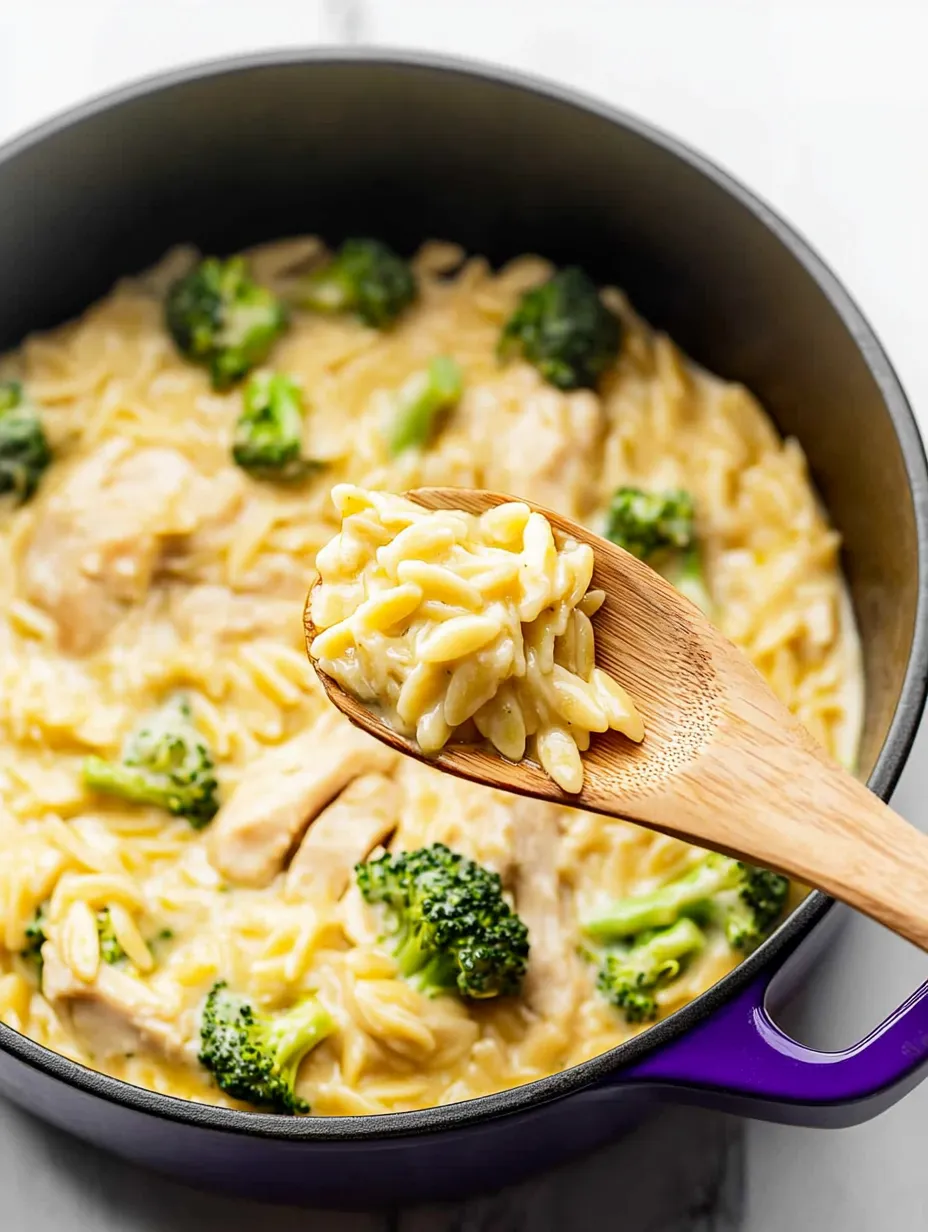 Pin it
Pin it
Create a restaurant-worthy presentation by serving this orzo in wide, shallow bowls with a light drizzle of extra virgin olive oil and a sprinkle of fresh herbs on top. This simple finishing touch elevates the visual appeal while adding a fresh aromatic element that complements the cooked herbs in the dish. A few grinds of black pepper add both flavor and visual interest to the finished plates.
Balance the richness of this dish by pairing it with a simple green salad dressed with a bright vinaigrette. The acidic notes from the dressing cut through the creamy cheese sauce while adding fresh, crisp textures to the meal. This accompaniment takes just minutes to prepare while making the overall dinner feel more complete and nutritionally balanced.
Tasty Variations
Create a southwestern twist by substituting pepper jack for the cheddar cheese and adding a drained can of diced green chiles along with the broth. Finish with chopped fresh cilantro and a squeeze of lime juice just before serving for a completely different flavor profile using the same cooking technique. This variation pairs beautifully with sliced avocado on top.
Develop a Mediterranean-inspired version by using feta instead of cheddar and adding halved cherry tomatoes, kalamata olives, and fresh spinach instead of broccoli. The spinach can be stirred in during the last minute of cooking until just wilted. This bright adaptation feels lighter while still providing satisfying creaminess and protein.
Transform this into a seafood dish by replacing the chicken with cooked shrimp or chunks of salmon added during the last few minutes of cooking. The seafood requires less heating time than chicken, but otherwise, the technique remains the same. Consider adding a splash of white wine to the broth mixture and finishing with fresh dill for seafood-complementary flavors.
Storage Secrets
Keep leftovers fresh by storing in a shallow airtight container in the refrigerator for up to three days. The shallow container allows for quicker cooling, which helps maintain better food safety and quality. Stir gently before reheating to redistribute ingredients that may have settled.
Revive refrigerated portions by reheating gently with additional liquid. Add a splash of chicken broth or a combination of broth and cream to loosen the mixture as the orzo will continue absorbing liquid even during storage. Heat over medium-low heat, stirring frequently, or microwave at 70% power with a damp paper towel covering the dish.
Transform day-old portions into a complete reinvention by adding a beaten egg and extra cheese, then pressing the mixture into a buttered baking dish. Bake until golden for a sliceable casserole that tastes intentional rather than like leftovers. Top with buttered breadcrumbs before baking for an extra-special touch.
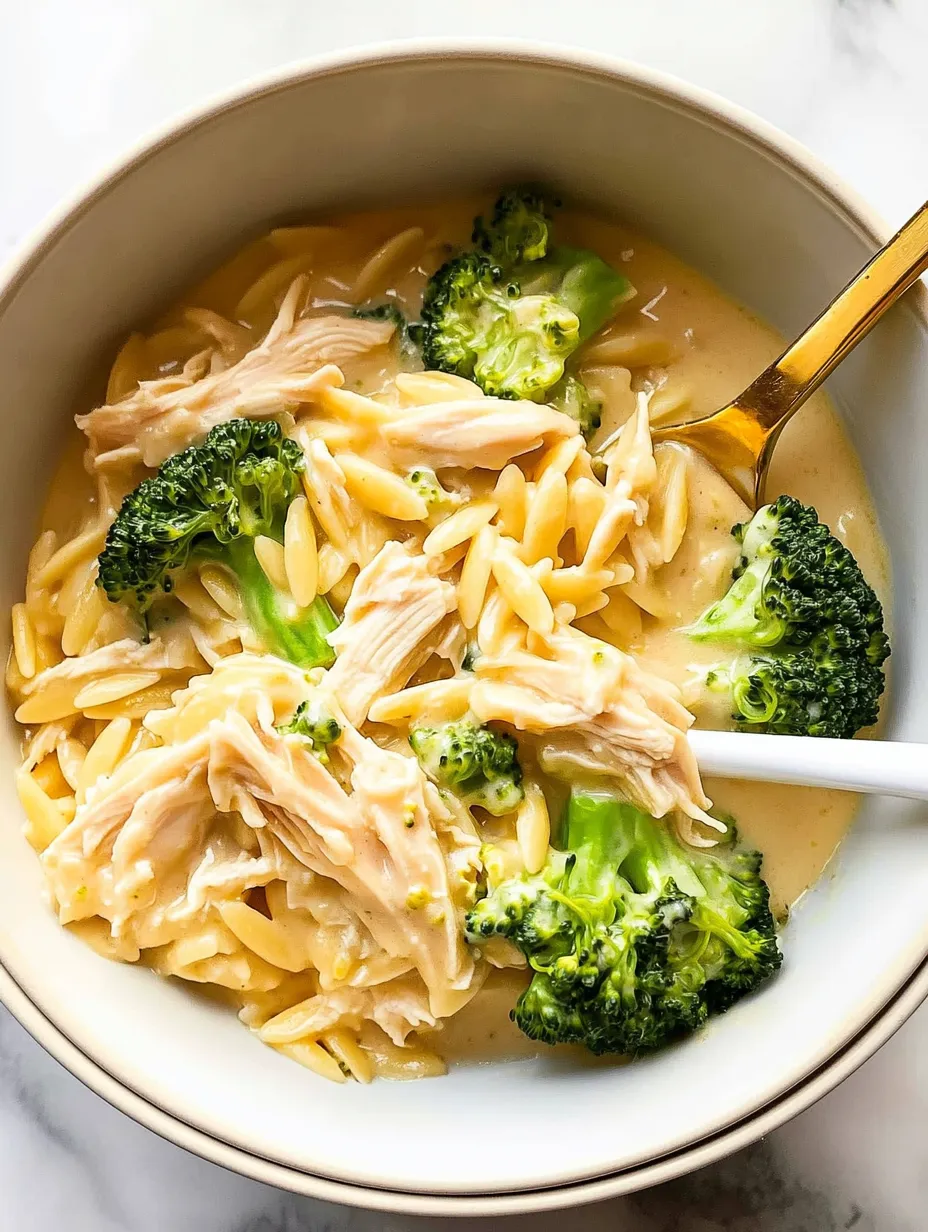 Pin it
Pin it
I discovered the importance of proper pot selection while developing this recipe. The first time I made it, I used a skillet that was slightly too small, resulting in orzo that didn't cook evenly and broccoli that steamed instead of sautéing properly. Learning from this experience, I now use my wider, deeper Dutch oven which provides ample space for ingredients to cook properly while allowing easier stirring without spills. Sometimes the simplest adjustments make the biggest difference in cooking success, particularly with one-pot meals where everything needs to cook properly together.
Frequently Asked Questions
- → Can I use something other than orzo pasta?
- Yes, you can substitute small pasta shapes like small shells or ditalini, but cooking times may vary slightly.
- → What if I don't have rotisserie chicken?
- You can use any pre-cooked chicken, or quickly sauté about 1 pound of diced chicken breast or thighs before starting the recipe.
- → Can I use frozen broccoli instead of fresh?
- Yes, frozen broccoli works well. No need to thaw - add it directly to the pot and maybe cook it for 1 minute less since it's already blanched.
- → How do I store leftovers?
- Keep leftovers in an airtight container in the refrigerator for up to 3 days. Reheat gently with a splash of milk or broth to maintain creaminess.
- → Can I make this lighter?
- You can use half-and-half or whole milk instead of heavy cream, though the sauce won't be quite as rich. Reduce the cheese to 1 cup for fewer calories.
